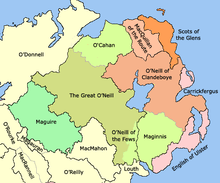Ó Catháin
The Ó Catháin, meaning "descendants of Cahan", were a sept of the Cenél nEógain branch of the Northern Uí Néill in medieval Ireland. They originated in the Laggan area in modern County Donegal, Republic of Ireland, and from there moved eastwards in the twelfth century, ousting the Uí Conchobair from Keenaght in modern-day County Londonderry, Northern Ireland. They held the lordship of Keenaght and Coleraine until the seventeenth century, to which it was commonly referred to as "O'Cahan's country". Under the sub-ordination of the Ó Néill clan of the Cenél nEógain, they held the privilege of inaugurating the chief of the Ó Néill by tossing a shoe over the new chief's head in acceptance of his rule.
There is also an unrelated sept of Uí Catháin in the province of Connacht, the Ó Catháin Uí Fiachrach.
See also
Name
The surname has been anglicised O'Cahan, Cahan, McCaughan, O'Kane, Kane, O'Keane, O'Kean, O'Keene, Keen, Keene, Kain, O'Kaine, and similar variations thereof.
History

The Ó Catháin sept of Cianachta first appear on record in 1138. A thirteenth-century chief of the family was Cú Maighe na nGall Ó Catháin. A heavily restored effigy at Dungiven Priory is sometimes associated with Cú Maighe, although it appears to date to the last quarter of the fifteenth century, and seems to be that of a later member of the sept.
By the late 16th-century, "O'Cahan's Country" became the county of Coleraine. The majority of Ó Catháin chiefs fled Ulster in the Flight of the Earls in 1607, and under the terms of Surrender and regrant they forfeited their lands to the English crown. During the subsequent Plantation of Ulster, County Coleraine along with parts of counties Antrim, Donegal, and Tyrone, where merged to form County Londonderry. After the Flight of the Earls in 1607, Domhnall Ballagh Ó Catháin, Chief of the Ó Catháin (and at one time knighted by the English Crown), was captured and sent to the Tower of London, where he died in 1626. There has been no Chief since.
See also
External links
- http://www.irishtimes.com/ancestor/surname/index.cfm?fuseaction=Go.&UserID=
- Ó Catháin Festival wepages